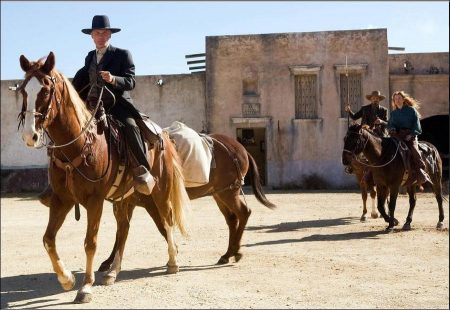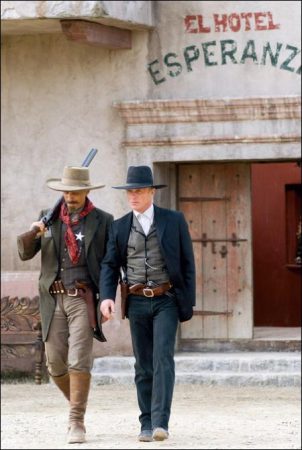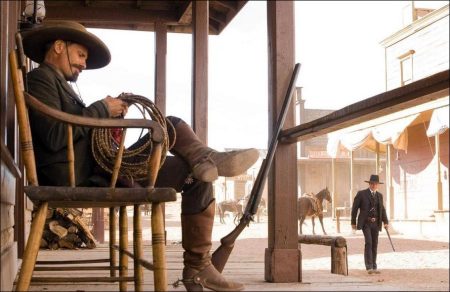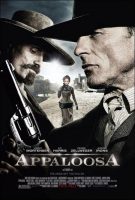Tagline: Feelings get you killed.
Appaloosa movie storyline. Set in 1882 in the Old West territory of New Mexico, city marshal Virgil Cole (Ed Harris) and his deputy and partner Everett Hitch (Viggo Mortensen), have made their reputation as peacekeepers in the lawless towns springing up in the untamed land.
1882, New Mexico Territory. Virgil Cole and Everett Hitch are itinerant lawmen, hired by desperate towns as marshal and deputy. The city fathers of Appaloosa hire them after Randall Bragg, a newly-arrived rancher with money and a gang of thugs, disrupts commerce and kills three local lawmen. Cole and Hitch contrive to arrest Bragg and bring him to trial, but hanging him proves difficult. Meanwhile, a widow has arrived in town, Allison French, pretty, refined, and good-natured. Virgil falls hard, and it seems mutual, but there may be more to Allie than meets the eye. Can friendship and skill with a gun overcome a pernicious villain and green-eyed jealousy?
Appaloosa is a 2008 American Western film based on the 2005 novel Appaloosa by crime writer Robert B. Parker. Directed by Ed Harris and co-written by Harris and Robert Knott, Appaloosa stars Harris alongside Viggo Mortensen, Renée Zellweger and Jeremy Irons. The film premiered at 2008 Toronto International Film Festival and was released in selected cities on September 19, 2008, then expanded into wide-release on October 3, 2008.
The film shares some narrative similarities with the 1959 Western Warlock, directed by Edward Dmytryk and starring Henry Fonda, Anthony Quinn and Richard Widmark. There is also a 1966 Western named The Appaloosa which stars Marlon Brando, but the two films are unrelated.
About The Production
I don’t kill people for a living, I enforce the law. Killing is sometimes a by-product. — Virgil Cole
When Ed Harris embarked on a family horseback-riding trip in 2005, he brought Robert B. Parker’s novel Appaloosa along for the journey. A character-driven tale about honor and camaraderie set against the backdrop of the Old West, the novel captured Harris’s attention.
“I was immediately drawn to the relationship between Cole and Hitch. After I read the first few scenes between these guys, I fell in love with their dialogue and their friendship,” says Harris. “These are two tough guys who’ve been riding together for more than 12 years and they just know each other. They don’t have to talk about their feelings necessarily, there’s an unspoken understanding between them. They’re very comfortable with one another and respect each other, and they have a great sense of humor together.”
Executive producer Michael London also gravitated to the source material. “I felt strongly about the novel from the first time I picked it up. There was something about the interplay between these two guys. There’s a traditional buddy movie at the core of the story.”
“What is most fascinating to me about the story is that it explores how Hitch and Cole’s friendship deals with the unexpected,” says producer Ginger Sledge. “It examines the potential for good and bad in each character.”
Realizing Parker’s novel was more than just a good read, Harris saw the cinematic potential and teamed up with Robert Knott to collaborate on the screenplay. “We explored the ways friendship could be expressed on screen through both the silence and banter between Cole and Hitch-how each of them played such an integral role in supporting each other along the way, how they dealt with the fear of death or lack thereof, and how they understood each other’s needs,” remarks Knott, who also serves as a producer on the project.
In addition to writing the screenplay for “Appaloosa” with Knott, Harris made the decision to direct and produce the film. He also stars in the role of Virgil Cole. “Ed is absolutely perfect for the part,” says author Robert Parker. “He looks the way I thought Cole would look. He has this economy of movement that Cole has. Ed has a distinct sense of self-containment; he’s never in a hurry, but he’s still a beat faster than most people. He also has a `he-does-what-he-sets-out-to-do’ kind of attitude, which is not unlike the character of Virgil Cole.”
“Ed brings an amazing strength of character that’s in every frame of the movie,” says executive producer Michael London. “He has a very powerful, quiet presence, which he brought to the character.”
In “Appaloosa,” Virgil Cole is an expert gunman who is committed to his trade as a man of the law. “Whether it’s the law that he brings to a town or the law of a territory, that is his life’s work,” offers Harris. “He believes in justice and in treating people fairly. He has a bit of a temper, but he’s also got a sense of humor about what he does. He’s a very loyal individual, and you see this in his friendship with Everett Hitch.”
“I had just finished reading Appaloosa at that time we shot `A History of Violence,’ and I gave it to Viggo and told him that I really wanted to make it into a film with him in it,” recalls Harris. “One of the greatest things about Viggo is his sense of loyalty. He’s a man of his word. Once he committed to the project, he was completely on board.”
“We see eye to eye,” says Mortensen of his experience working with Harris. Mortensen was also drawn to the subtlety in the screenplay’s dialogue and the friendship between two lawmen in the Old West. “I think Cole trusts Hitch more than anyone else in the world, specifically because Hitch is very honest with him, even when it’s difficult to bring certain things to Cole’s attention,” says the actor. “That is my definition of a good friend: somebody who is brave enough to tell you the truth even when it’s not what you want to hear.”
“Hitch really is the reason that Cole’s still alive,” says Harris. “The two met in a standoff between Cole and another gunslinger.” It was Cole and Hitch who lived to tell about it. “Hitch was originally trained at West Point, but he gave up the life of a soldier and wandered West. Then he met Cole, who was looking for a right-hand man in his peacekeeping business. Hitch saved Cole’s life, and Cole, in return, has given Hitch a life.”
While they have spent the last 12 years bringing peace to lawless towns, everything changed in Appaloosa, “in part because it was time for things to change, but mostly because of the influence of Allison French,” Mortensen suggests.
Oscar winner Renée Zellweger plays the role of Allison French, a beguiling widow who arrives in Appaloosa and immediately draws the attention of Virgil Cole. “I was intrigued by the mystery surrounding the character of Allison French,” states the actress. “Just from reading the script, there’s not a lot you can presume about her. Judging by the way she dresses and acts, you can probably guess that she’s a city girl and that she’s educated, but that’s about it. She simply rolls into town with a dollar in her pocket and a story about a deceased husband. You don’t know anything more, except that she plays piano and likes to be called Allie.”
Together, Cole and Hitch meet the young widow in a restaurant, but have very different impressions of the enigmatic newcomer. “Cole has never met anyone quite like Allie, so he becomes instantly fascinated,” says Harris.
On the other hand, Mortensen notes, “Hitch thinks that she’s a bit too forward; a bit too inquisitive for his taste. As soon as she starts asking all these questions, Hitch becomes a little wary of her. But Cole is immediately taken with her. Cole is someone who’s so dedicated to serving the law that he’s somewhat of a workaholic,” continues Mortensen. “So despite Hitch’s skepticism about Allie, he thinks it’s nice to see Cole let loose a little and have some fun. But as Cole and Allie’s relationship gets more serious, it becomes problematic. She seems to be too much of a distraction. And distractions can be dangerous for lawmen.”
Zellweger counters, “Allie is not all good or all bad, she’s somewhere in-between. I think you can empathize as she stumbles along and tries to make her way. I’ve never played a character like that, and I found it very rewarding. I love Allie’s determination. I love that she’s so weak, and yet she’s so determined to do the best that she can. She’s a survivor. I’ve kind of assumed that Allie is a graduate of the school of hard knocks. She is doing the best she can based on what she’s been taught during these times as a woman who’s not attached and has come upon hard times.”
“Renée brings vitality and honesty to the role of Allie and her own unique way of being,” remarks Harris. “I don’t believe that Allie is calculating. She’s not someone who is dark and mean-spirited. She is who she is.”
Another powerful character in “Appaloosa” is the local rancher Randall Bragg, who has gotten used to being above the law. Played by Oscar winner Jeremy Irons, “Bragg is a man who has a lot of connections and he’s out West trying to make his fortune by taking over the local copper mines around Appaloosa,” says the actor. “In the course of taking over this area, he allows his men to run riot in town.”
The time period and setting in which “Appaloosa” takes place appealed to the English actor. “The frontier men spoke with their guns,” Irons notes. “This was a time when the West was just beginning to be developed and the law was coming. Laws were added and changed so fast that suddenly you had to do things a certain way, which doesn’t sit well with a man like Randall Bragg.”
Mortensen adds, “It was a very interesting time. I looked into Southwestern history and the history of outlaws and lawmen, and there often appears to have been a very thin line between them. In fact, Cole and Hitch are not that far removed from the `outlaws’ that they’re up against. There’s not much difference between them in some moments; they both have displays of temper and violence.”
Rounding out the cast in “Appaloosa” are Timothy Spall, James Gammon and Tom Bower as Appaloosa’s aldermen; Lance Henriksen as Ring Shelton, a rival gun-forhire who allies himself with Bragg; and Ariadna Gil as Katie, an insightful working girl who befriends Everett Hitch. Additionally, Harris made “Appaloosa” a family affair by casting his father, Bob Harris, in the role of Judge Elias Callison. They had previously worked together on “Pollock.”
We’d been keeping the peace together for the last dozen years or so. And as we looked down on a town called Appaloosa, I’d no reason to doubt that we’d be doing just that for the foreseeable future. But life has a way of making the foreseeable that which never happens…and the unforeseeable that which your life becomes. — Everett Hitch
As Harris and Knott wrote the screenplay for “Appaloosa,” they envisioned the fictional town in which the story takes place to be in New Mexico or Arizona. In fact, the filmmakers considered filming in Arizona, New Mexico and Texas before finally deciding on northern New Mexico.
Harris recalls, “I wanted to make a film that had the right scope to depict the magnificent country in which the story takes place-in the Southwest, in New Mexico. I thought Parker’s story deserved that. I always loved New Mexico. The Ford Ranch in Santa Fe ended up being our best bet in terms of scenery and intangibles. It’s a very film-friendly situation because a lot of production folks have moved from Los Angeles to New Mexico, so there’s a ton of skilled craftspeople there. Aesthetically it was the best place to shoot. All you’ve got to do is get out here and experience it. Big sky. Hills. Desert. Quiet.”
“Appaloosa” is director of photography Dean Semler’s seventh film shot in New Mexico. “Santa Fe is ideal for shooting Westerns. You’ve got such a variety of landscapes,” Semler says, referring to the state’s picturesque offerings of tabletop mesas, sandstone buttes, high desert chaparral, alpine terrain and river basins.
Semler shot the film in anamorphic, wide-screen aspect ratio, often utilizing wideangle lenses to capture the grand Southwestern panoramas. “We used a lot of beautiful still frames with landscapes and people in them. So we didn’t isolate the background, we’ve included it, which was beautiful. We made the most of the landscapes and the characters in it,” notes Semler.
“The color palette in New Mexico is really incredible on screen,” observes Ginger Sledge. “Dean captured amazing vistas, with rich and saturated tones. You’ve got the vibrant blue sky and beautiful greens with shades of tan, pale pink and orange mixed in. This land is amazing.”
“Appaloosa” was filmed from late September to early December 2007 in and around Santa Fe. Various locations included the multi-hued sandstone cliffs of Abiquiu and alongside the Chama River, where the autumn cottonwoods were turning golden. The town of Appaloosa was constructed on designer Tom Ford’s Cerro Pelon Ranch in Galisteo. The scene where Bragg’s men chase Cole and Hitch was filmed crossing the Rio Grande River near Algodones. While most of the film was shot in New Mexico, the production chose to shoot one climactic shootout in Austin, Texas, which doubled for the fictional town of Rio Seco.
In contrast to the rich hues of the New Mexican landscape, production designer Waldemar Kalinowski worked closely with Harris to bring the town of Appaloosa to life in a way that reflected the town’s depressed condition. “Appaloosa is experiencing a downturn in its economy, so we have a layer of what has been and what is,” says Kalinowski. “We were very specific from the beginning. It’s not just a dirty little town in the middle of the West. It’s a town that was established by the mining company.”
To construct the town of Appaloosa, Kalinowski’s team used a combination of wood, brick and adobe, a building material native to the Southwest. While most structures were mainly built with wood, some principal buildings, such as the Boston House Hotel and Saloon, were built with brick. The bank building has a stone façade, and both the mining company and church are adobe buildings.
Kalinowski covered the interior walls of the Boston House Hotel and Saloon with a present-day copy of opulent William Morris wallpapers, which were designed in England. “The William Morris wallpaper is very patterned and represent a visual idea having to do with the return to nature, and people interested in naturalism. Our wallpapers were produced in London and shipped to us.”
Outfitting the characters in “Appaloosa” was the task of costume designer David Robinson, who scoured old photographs and Western antiques in his research. Robinson found similarities among men’s fashion in the day and reasoned that the similarities stemmed from the practicalities of the situation. “For instance, you wear a bandana to keep your neck from chafing, and you’d wear a vest because it gives you that extra layer,” the designer offers.
Additionally, the costume designer aimed to strike a balance between fashion and realism. “Photography at the time was a new invention, and those who had their photos taken were probably more dressed up than they normally would be for day-to-day life,” Robinson notes.
In creating the costumes for Virgil Cole, says Robinson, “Cole has a classic style. He’s often seen in a Prince Albert-style blazer jacket in charcoal gray along with black pants and striped period shirt. He’s very no-nonsense. And everything is well-kept. “Hitch is more down-to-earth. His colors are browns and greens,” continues Robinson. “He’s very practical, so when something rips, he just sews it up. He has a leather saddle strap that’s been added to his jacket so his gun belt won’t wear on his jacket.”
Robinson designed, sketched and built all of the outfits for Zellweger’s character, Allison French, in his costume shop. The designer points out, “Allie’s not your typical woman in a Western who’s typically a sort of a prop. She’s definitely a little bit more fashionable since she’s coming from a big city. She’s from an upper-middle class background, so we looked at more upscale fashion of the 1880s and based her wardrobe on that. Allie’s outfits have a lot more color compared to everyone else’s in Appaloosa. We first see her in a bronze and navy blue dress. Then she is seen in a variety of colors like green, burgundy, and her dresses are mostly silk.” Of particular note, one silk-satin iridescent dress for Zellweger’s character features an actual lace collar used in the 1880s. Additionally, the modern cowboy hat was just being developed at this time, so the hats in “Appaloosa” feature rounded crowns or telescoped crowns, rather than dented crowns with curved brims, as on the modern cowboy hat.
Another key detail in the making of “Appaloosa” was the use of historically accurate firearms. The most noticeable gun in the film is Everett Hitch’s eight-gauge-a rare weapon also called a “punt gun” or a “market gun.” At 50 inches long and weighing more than 11 pounds, it’s an intimidating weapon. The cumbersome eight-gauge was most often used while sitting on a swivel in a boat, to fire into large flocks of ducks or geese for food and feathers. Technically a shotgun rather than a rifle, the eight-gauge shoots a number of pellets or buckshot, which spread out as they come out of the muzzle. Virgil Cole’s trusty pistol is a bone-handled Colt 45, vintage 1873.
Several dozen horses were used in the filming of “Appaloosa,” mostly large, sturdy quarter horses, along with some appendix horses and mules. Head wrangler Rex Peterson studied old Frederic Remington paintings to research the horse tack of the 1880s. “The horses are being ridden with fancy period silver bits and bridles,” says Peterson. “The American Indians are riding with plainer saddles and bridles.” Harris and Mortensen did their own riding, mounted on large, solid-colored bays and sorrels. “They’re both excellent riders,” says Peterson.
The steep mountainsides in the Abiquiu area demanded careful planning and intense focus for all involved. Viggo Mortensen recalls, “We did all the hardest stuff in the first week; climbing up steep hillsides with rocky terrain. Rex selected two very impressive steeds for Cole and Hitch to ride because when they first come into town, they want to make an impression. They come in on horses that are much bigger than the other ones in town.”
“The image of Cole and Hitch riding into town in this fashion is classic Western iconography,” offers executive producer Michael London. “They’re two characters who set out to right a wrong. It sounds like a simple and obvious task, but they ultimately discover the nuances and complexities of the situation that make their jobs impossible to accomplish without compromising something along the way.”
“It’s not a revisionist Western,” states Mortensen. “It’s not a movie about 1882 seen through our eyes as much as it is a picture that’s without judgment of people as they seem to have behaved back then. The standards of behavior were very different. In some ways, there were higher standards of politeness and chivalry, but in other ways, people were much more direct and brutal towards each other. Neither Ed nor I, as the central male characters, are trying to justify the violence that comes with our jobs in this story, or to make our characters seem more heroic than they are.”
Harris concludes, “The most important thing to Robert Knott and me in writing the screenplay was staying true to Robert Parker’s intent. Once on set, we strove for truth in each character’s individual intentions and their relationships. Though we’re in the 1880s, human nature still dictates how people react and treat other people. Issues and conflicts of friendship, loyalty and betrayal are still very relevant today. To see it all come together with such a great team, I really couldn’t have asked for more. It’s been a tremendously rewarding experience.”
Appaloosa (2008)
Directed by: Ed Harris
Starring: Viggo Mortensen, Renée Zellweger, Timothy V. Murphy, Daniel T. Parker, Ed Harris, Boyd Kestner, Benjamin Rosenshein, James Gammon, Cerris Morgan-Moyer, Timothy Spall, Tom Bower
Screenplay by: Ed Harris
Production Design by: Waldemar Kalinowski
Cinematography by: Dean Semler
Film Editing by: Kathryn Himoff
Costume Design by: David C. Robinson, Timothy Everest
Set Decoration by: Linda Lee Sutton
Art Direction by: Steve Arnold
Music by: Jeff Beal
MPAA Rating: R for some violence and language.
Distributed by: New Line Cinema
Release Oaüe: September 19, 2008
Views: 134







